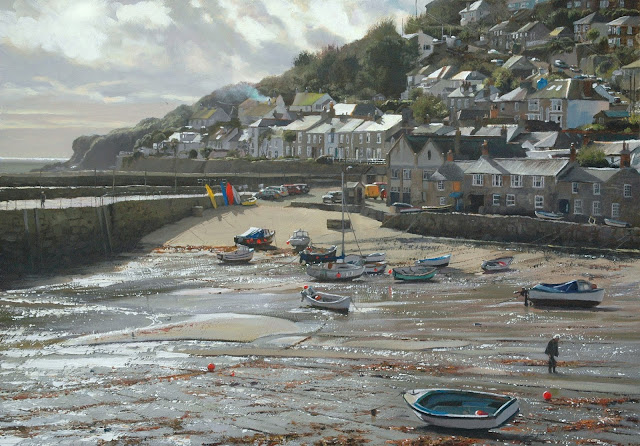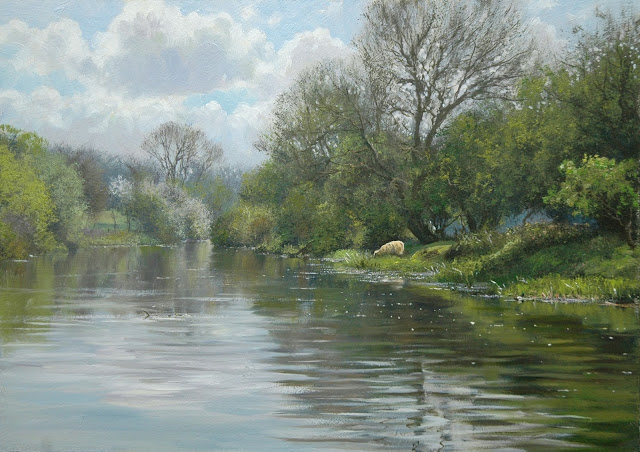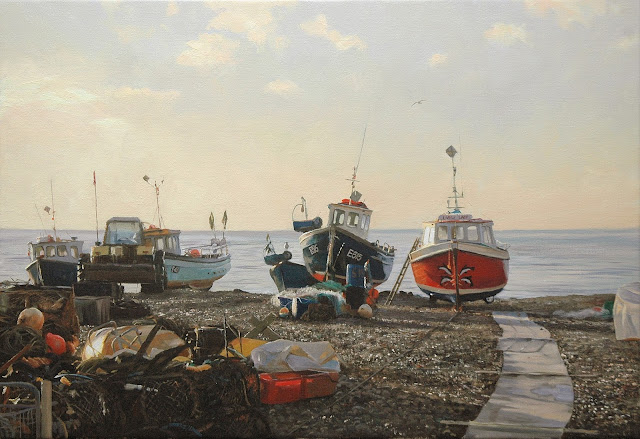"Where have you been?" I hear you all saying! Yes, just been so busy at the gallery, organising more lighting and hanging upwards of eighty fabulous new paintings from our brilliant artists, it's been hard finding any time to paint. Did I mention my gallery before...Peter Barker Fine Art
If any of you would like to be kept up with our monthly newsletters if you aren't already on our gallery mailing list, drop me a line nd I'll add your email address, thank you.
Anyway, this painting above I did as a demo to the lovely Derbyshire folks at the Breaston Art Group a couple of weeks ago. Below is how far I got at the end of the demo, in its raw state. I spent some more time in the studio yesterday tidying it up to exhibition standard, and Jane sold it whilst it was resting in the gallery, unframed.
The hook for the painting really, apart from the snow itself, which is so lovely to paint, was that strip of yellowy-orange sky above the blue of the distant trees. The camera hasn't quite picked up the subtle blue/mauve colours of the sky and the greenish/reds in the banks - it all looks rather brown in the photo, which it isn't.
As I said during the demo, the main thing to check in a painting is to paint the tones you see, not what you know - ie, we all know snow is white, but it is only white when the sun is shining on it. Here, it appears much darker, as can be seen against the white background around the photo on Facebook at https://www.facebook.com/peter.barker.1485?fref=ts, and that is the key - if I painted the snow dead white, the sky would appear much darker, and the light in the sky, looking straight into the sunlight, wouldn't appear as light as it is. That really is the key for the amateur painter - to delete what you know - that leaves and grass are green, and snow is white - or what you think you see, and learn to REALLY look at what's in front of you, squint and see the true tones of what you're painting - paint the shapes and their relative tones, and the resulting painting will look more like the reality in front of you. Oh dear, more secrets revealed - I'm going to have to kill you all...
If any of you would like to be kept up with our monthly newsletters if you aren't already on our gallery mailing list, drop me a line nd I'll add your email address, thank you.
Anyway, this painting above I did as a demo to the lovely Derbyshire folks at the Breaston Art Group a couple of weeks ago. Below is how far I got at the end of the demo, in its raw state. I spent some more time in the studio yesterday tidying it up to exhibition standard, and Jane sold it whilst it was resting in the gallery, unframed.
The hook for the painting really, apart from the snow itself, which is so lovely to paint, was that strip of yellowy-orange sky above the blue of the distant trees. The camera hasn't quite picked up the subtle blue/mauve colours of the sky and the greenish/reds in the banks - it all looks rather brown in the photo, which it isn't.
As I said during the demo, the main thing to check in a painting is to paint the tones you see, not what you know - ie, we all know snow is white, but it is only white when the sun is shining on it. Here, it appears much darker, as can be seen against the white background around the photo on Facebook at https://www.facebook.com/peter.barker.1485?fref=ts, and that is the key - if I painted the snow dead white, the sky would appear much darker, and the light in the sky, looking straight into the sunlight, wouldn't appear as light as it is. That really is the key for the amateur painter - to delete what you know - that leaves and grass are green, and snow is white - or what you think you see, and learn to REALLY look at what's in front of you, squint and see the true tones of what you're painting - paint the shapes and their relative tones, and the resulting painting will look more like the reality in front of you. Oh dear, more secrets revealed - I'm going to have to kill you all...




















































